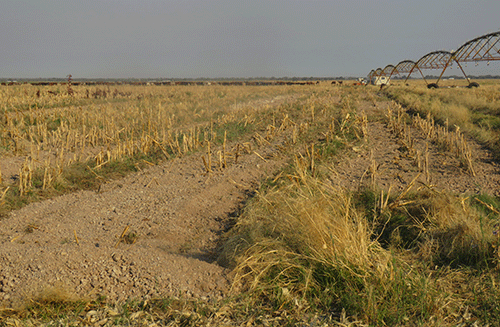Absalom Shigwedha
Productive land is one of the world’s most valuable assets in banishing poverty and creating shared prosperity but this can only be achieved if enough nutrients are added to the soil so that it can produce more food and lead to food security.
In an effort to produce more food, the private operator of the Musese Green Scheme in Kavango West region, Winni Metzger, is currently applying clay soil with lime and finer material.
‘We are very hopeful that maize will grow better in the next planting
season. We will improve the soil,” Metzger told Agri Today at Musese recently.
The clay soil is extracted from a site next to one of the green scheme’s fields, closer to the Okavango River. Metzger said he is putting in about N$4 million in this exercise and is hopeful that he will get it back through improved food production.
He has also placed about 3 000 of his cattle into the fields at Musese so that they can feed on remnants of the harvested maize and to trample on the maize stalks.
When the clay soil is spread on the fields, the fields are then irrigated so that it is well mixed with the trampled maize stalks, cattle urine and cattle dung. He advised that all green schemes can do the same, so that food production is enhanced. Metzger said he allows his cattle to stay in one field of 15 hectares for about six weeks.
“All green schemes can put in cattle after harvesting so that they destroy the
maize stalks, release the cow dungs and urine to better the soil. As you can see, my cattle are in good condition and if you are to slaughter one, you will get a good price,” he said.
Meanwhile, Metzger has in May this year built a 450 KW solar energy plant at Musese Green Scheme, in an effort to avoid losses due to frequent power outages in Kavango West. The last planting season at Musese Green Scheme was hampered by continuous power outages, which led to young maize crops withering.
“This is a long-term investment and the reason to have this plan is to reduce power cost by about N$3 million,” said Metzger.
Metzger is also a professional borehole driller and has thus far drilled 22 boreholes between Nkurenkuru and Katwitwi for both communities and schools and plans to drill two more for the Nzinze and Siku communities.
He said they can now irrigate a field of 250 hectares using solar power. Metzger added that it will be a good thing if all green schemes can set up solar power plants as this would lead to a reduction in power costs.
Inaugurated in 1977, the Musese Green Scheme currently has 105 employees and hires about 200 temporary employees to assist with other activities. The main aim of green schemes in Namibia is to achieve food security, the second goal is to educate
the future generations so that the country can have future farmers, really to be profitably and plough back into the community.
* Absalom Shigwendha is a freelance journalist specialising in agriculture and environmental reporting.


